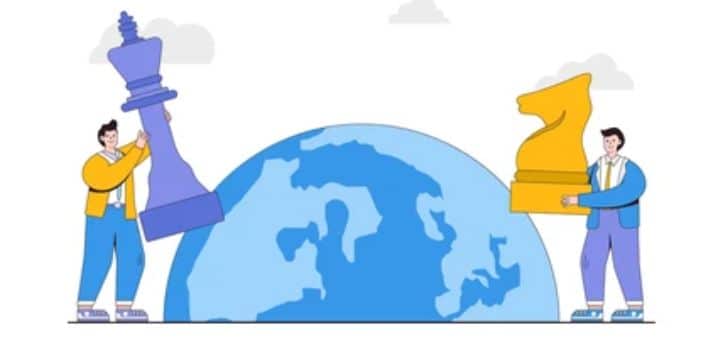The Earth, a dynamic and constantly changing planet, is shaped by various geological forces that act both beneath the surface and across its crust. These forces, often referred to as “geological tensions,” are responsible for shaping the planet’s surface, creating mountains, earthquakes, volcanoes, and influencing the broader geological processes that drive the Earth’s evolution. This article will explore the concept of geological tensions, the causes behind them, their impact on Earth’s surface, and their significance in the field of geology. What are Geological Tensions? Geological tensions refer to the stress and strain that build up in the Earth’s crust due to various geological processes.

These processes are driven by the movement of tectonic plates, volcanic activity, and the forces generated within the Earth’s mantle. Geological tensions can result in deformation of the Earth’s crust, which may manifest as faults, fractures, folds, and various landforms. At the heart of these tensions is the concept of plate tectonics, which explains how the Earth’s outer shell is divided into several large and small rigid plates that float on the semi-fluid asthenosphere beneath them. The movement of these plates relative to each other creates immense pressure, resulting in geological tensions. These tensions are often categorized into three main types: compressional, tensional, and shear stresses.
1. Compressive Tensions.
Compressive tension occurs when two tectonic plates move toward each other, causing the crust to compress. This type of stress is most commonly associated with the formation of mountain ranges, as the Earth’s crust is forced to fold, fault, and buckle under immense pressure. The collision of plates can create complex geological structures, such as thrust faults, where one section of the crust is pushed over another. Examples of compressive tectonic boundaries include the collision of the Indian plate with the Eurasian plate, resulting in the formation of the Himalayas.
2. Tensional Tensions.
Tensional tension occurs when two tectonic plates move away from each other, leading to the stretching of the Earth’s crust. This type of stress typically occurs at divergent boundaries, where plates are pulled apart due to upwelling material from the mantle. As the crust stretches, it may crack, forming rift valleys and mid-ocean ridges. A classic example of tensional stress is found along the East African Rift, where the African plate is pulling apart from the Arabian plate, leading to the creation of deep valleys and volcanic activity.

3. Shear Tensions.
Shear tensions arise when two plates slide past each other horizontally. In this scenario, the stress is not directed toward or away from each other, but rather along the plate boundary. This type of stress results in lateral displacement, leading to the formation of strike-slip faults. A famous example of shear tension is the San Andreas Fault in California, where the Pacific plate slides past the North American plate, causing significant seismic activity.
Causes of Geological Tensions.
The primary cause of geological tensions is the movement of tectonic plates. The Earth’s lithosphere is divided into several large and small plates that float on the underlying, more fluid asthenosphere. These plates are constantly moving, driven by convection currents in the mantle and other forces, such as gravitational pull.
1. Mantle Convection: The movement of heat within the Earth’s mantle causes convection currents, where hot material rises toward the surface, and cooler material sinks. This process helps drive the movement of tectonic plates, creating stresses at plate boundaries.
2. Subduction Zones: At subduction zones, one tectonic plate is forced beneath another. As the subducting plate descends into the mantle, it generates immense compressive forces, leading to the creation of mountain ranges, deep ocean trenches, and volcanic activity.
3. Mid-Ocean Ridges and Rift Zones: At divergent boundaries, tectonic plates move apart, allowing magma to rise and form new crust. This process generates tensional forces, which stretch and crack the Earth’s crust, creating features like rift valleys and ocean ridges.
4. Continental Collision: When two continental plates collide, the resulting compressional forces lead to the formation of massive mountain ranges. The Himalayas, for example, are the result of the collision between the Indian plate and the Eurasian plate.

Geological Tensions and Their Impact.
The geological tensions present within the Earth have significant impacts on the planet’s surface and its ecosystems. These impacts can be seen in the formation of mountain ranges, earthquakes, volcanic activity, and the reshaping of Earth’s landforms. Earthquakes One of the most dramatic consequences of geological tensions is the occurrence of earthquakes. As tectonic plates move and accumulate stress, the Earth’s crust can suddenly rupture along faults, releasing a massive amount of energy. This energy is felt as seismic waves, which can cause ground shaking, landslides, and the destruction of infrastructure.
The release of tension along fault lines is a critical mechanism behind the occurrence of earthquakes. Notable earthquake-prone regions include the Pacific Ring of Fire, where tectonic plates are particularly active. VolcanoesTensional and compressive stresses can also lead to volcanic activity. In areas where tectonic plates are being pulled apart (such as mid-ocean ridges or rift valleys), magma can rise from the mantle, leading to the formation of volcanoes. Subduction zones, where one plate is forced beneath another, are also hotspots for volcanic activity.
The collision of plates in these zones causes the subducting plate to melt, leading to the formation of magma that can erupt through the Earth’s crust.Mountain Building Geological tensions are directly responsible for the formation of mountain ranges. Compressive forces at convergent plate boundaries cause the Earth’s crust to fold, fault, and thrust upward, creating towering mountains. The Himalayan mountain range, for example, continues to rise as the Indian and Eurasian plates converge. The process of mountain building is slow but relentless, with some ranges rising by centimeters every year due to tectonic stress.
Ocean Basins and Continental Drift Geological tensions also play a key role in the process of continental drift, which leads to the opening and closing of ocean basins. At divergent plate boundaries, tensional stress causes the sea floor to spread, forming new ocean basins. On the other hand, compressional stresses at convergent boundaries can lead to the closing of ocean basins and the eventual collision of continents. This ongoing process of plate movement is responsible for the reshaping of Earth’s continents over geological timescales.

Conclusion
Geological tensions are fundamental to understanding the dynamic and ever-changing nature of the Earth. These tensions, driven by the movement of tectonic plates, shape the planet’s surface through processes such as mountain building, earthquake activity, volcanic eruptions, and the shifting of continents.By studying the causes and effects of geological tensions, scientists gain critical insights into the Earth’s past and future, helping to predict geological hazards and better understand the mechanisms that drive the Earth’s evolution. The Earth’s geological tensions are a testament to the power and complexity of the natural forces that continue to shape our planet.




